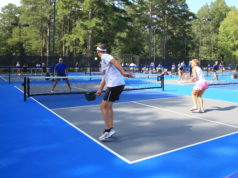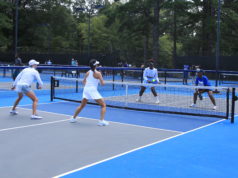Stocking your pantry for the best on-court performance
By Page Love, MS, RDN, CSSD, LD; and interns Morgan Laudick and Noelle Mauro
Whether you are hustling between work, school, and weekend tennis matches, or simply striving to keep your household running smoothly, appropriate nutrition is essential to meet the demands of the day and to have enough energy to play tennis after school or work. Players can better prepare their minds and bodies to manage their increased stress load when they remain optimally fueled throughout the day. School or work lunches are the pre-match/practice choices for these afternoon and early evening fuel needs.
Just remember some simple guidelines for putting together a balanced lunch: About half of your plate should be comprised of fruits and/or vegetables, one-quarter lean protein, and one-quarter whole grains or starchy veggies, with low-fat dairy, cheese, or yogurt on the side. If training is more intense or if it is close to a match day, you might need to increase the number of whole grains/starches to half of your plate, and fruits and/or vegetables and lean protein to one-quarter of each. You can visit Choosemyplate.gov for more information on basic portion and nutritional needs.
How do I grocery shop to meet these needs and make sure I am fueled properly for a practice or match? When traveling for matches, ensure you have foods you enjoy and that maintain your energy levels. Stock up on nutrient-dense, familiar foods. It is important to have plenty of complex carbohydrates. You also will want to make sure you have fruits and vegetables, as well as recovery options after your matches. Use this “tennis shopping list” to ensure you are stocked with what you need to fuel you on and off the court.
Grains
Most whole grains have a long shelf life, making them a great item to always have on hand. They are an important part of any athlete’s diet, and are essential in pre-workout snacks and pre-match meals or recovery. The fiber content keeps you feeling full, and as the number-one fuel source for muscles, these complex carbohydrates will be readily available to use as fuel during play. A few of our favorites include whole-grain bread/bagels, oatmeal, brown rice, popcorn, potatoes, pretzels, beans, and energy bars (high-carb – PowerBar, CLIF BAR, Pro Bar, Gatorade Fuel Bar).
Fruits
Fruits contain many vitamins, minerals, and fiber that help reduce inflammation and can promote the healing of tennis injuries. The natural sugar (fructose) can give you a quick burst of energy at the beginning of a match, and fruits can be considered a “2 for 1,” as they aid in hydration. Stock up on applesauce (no sugar added), fruit pouches, dried fruit and fruit leathers, apples, bananas, berries, citrus, and melons.
Vegetables
Vegetables have a high-water content as well, which can help keep you hydrated. They also contain higher amounts of potassium, magnesium, and iron that help prevent muscle cramping. An added benefit is that they contribute to neuromuscular transmission, which allows your brain to communicate with your muscles during a match. Great vegetables to keep on hand are dark, leafy greens for salads; colorful veggies like bell peppers, tomatoes, carrots, and squash; frozen vegetables such as broccoli and spinach; canned beans; and pickles.
Dairy
This food group is often neglected by athletes due to sensitivities, but dairy provides so many great benefits. They contain a large amount of calcium, which is essential for the building and maintenance of strong bones and muscle contraction. Calcium also aids in regulating your heart rate, which is key for a successful tennis match. Dairy products also can be a reliable source of protein for an after-match recovery. Examples of key dairy products include low-fat milk and yogurt, part-skim cheeses, frozen yogurt, fortified almond milk, and dairy-based smoothies.
Protein
Its function to promote muscle repair, recovery, and growth makes protein an essential macronutrient for post-tennis recovery. Studies have shown that consuming protein 30-45 minutes after a match can help significantly reduce muscle soreness and promote quicker repair. The goal in protein consumption is to eat half your body weight in grams of protein. Excellent protein choices are boneless, skinless chicken breasts; ground turkey or lean red meats; canned tuna or salmon; fresh seafood; and tofu or other meat alternatives.
Fats/Oils
Fats are extremely beneficial for athletes as secondary fuel sources. Unsaturated fat (from vegetables) helps to promote heart health by lowering cholesterol and improving blood flow. They also boost your immune system. Examples of healthy fats are olives, nuts and nut butters, avocados, hummus, yogurt-based and oil & vinegar dressings, olive and canola oil, and vegetable cooking spray.
In addition to these food groups, fluids are important for athletes’ nutrition. By staying hydrated you can regulate your temperature while also delivering nutrients and lubricating your joints. In addition to water, drink sport beverages on the court. Off the court, choose water, vegetable juices, 100-percent natural fruit juices, and dairy products to meet the rest of the 2-3 liters most of us need during the day (and up to 1 additional liter per hour in hot months for on-court needs).
Now that you have some ideas of training diet staples, it is time to refill your pantry and fridge for peak performance!
Easy dinner idea using an item from the food groups listed above: Burrito bowl
Mix 1/2 cup rice, 1/2 cup black beans, and 1/2 cup corn with either ground chicken or turkey, 1/4 cup salsa, and optional cut-up peppers and a green lettuce base. Top this off with 2 Tbsp. of guacamole and 2-4 Tbsp. of low-fat shredded cheese
Easy snack idea that can be taken on the go: Trail mix
Choice of your favorite grain (1 ½ cups): can be whole grain pretzels, Chex Mix cereal, Cheerios, Bagel chips, or popcorn.
Choice of your favorite fruit (1 cup): could be dried cranberries, cherries, blueberries, bananas, mangos, or raisins.
Choice of nuts or seeds (1 ½ cups): could be almonds, pecans, peanuts, cashews. For more additional beneficial nutrients, consider adding seeds like raw pumpkin seeds, sunflower seeds or sesame seeds.
Choice of a fun addition (½ cup): you can add something sweet to make it fun, like dark chocolate, peanut butter chips, candy (M&Ms) or another sweet treat you enjoy.
Easy lunch idea to pack for in between matches or at school: Homemade launchable
3 slices of lean luncheon meat (Turkey, Chicken, Roast Beef, ham), 2 slices of cheese of your choice, 10 Ritz crackers OR any type of your favorite salty grain, one our favorites are pretzels, also on the side you can include 8 baby carrots OR ½, 1 clementine, and 2 Belvita cookies. Add a side of Greek yogurt or Ranch.
Easy filling breakfast to start off your day the right way: Egg breakfast
2 eggs (cooked your preferred way), 2 slices of whole grain toast (with 2 tbsp of butter total) OR ¾ cup of oatmeal, and ¾ cup of Greek yogurt with ½ cup of berries.
Page Love is an avid ALTA participant and sport dietitian/nutrition advisor for the WTA and ATP professional tours, and serves on the USTA sport science commission and has a private practice in Atlanta. You can reach her at nutrifitga.com. Morgan Laudick is a current student athlete at Emory University and plans to become a sport dietitian. Noelle Mauro is currently pursuing her master’s in Nutrition at Samford University.




